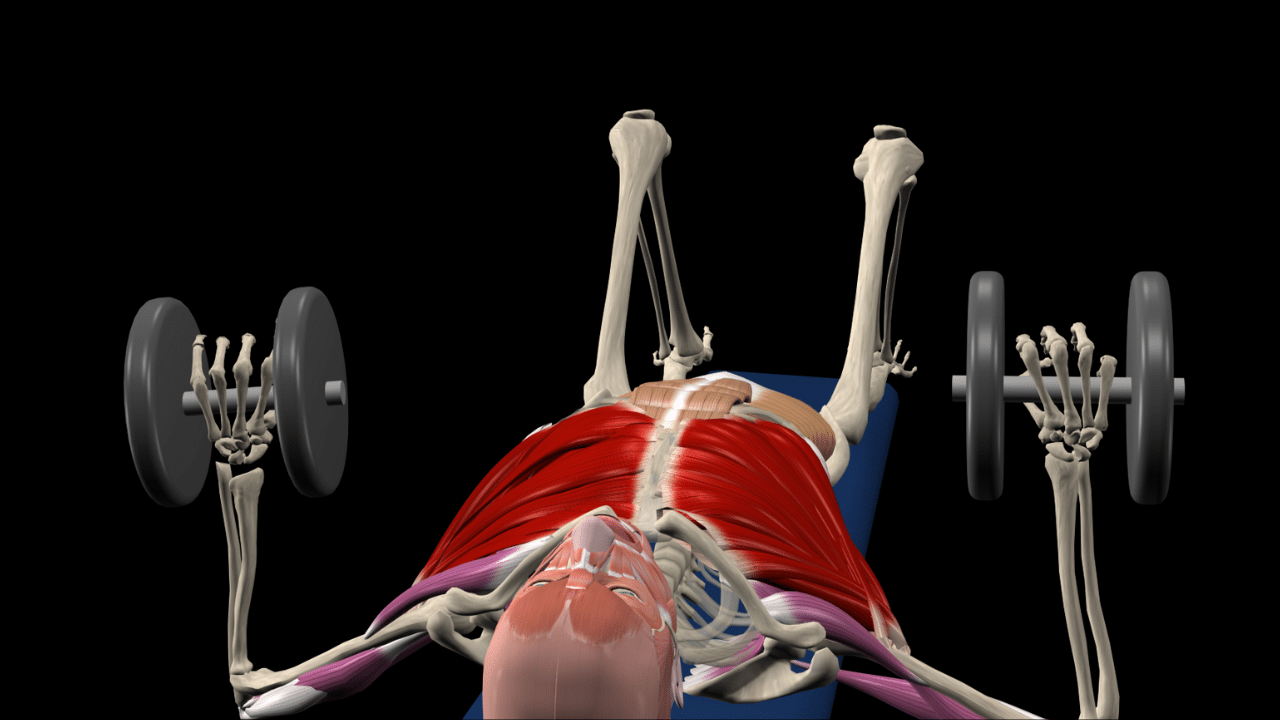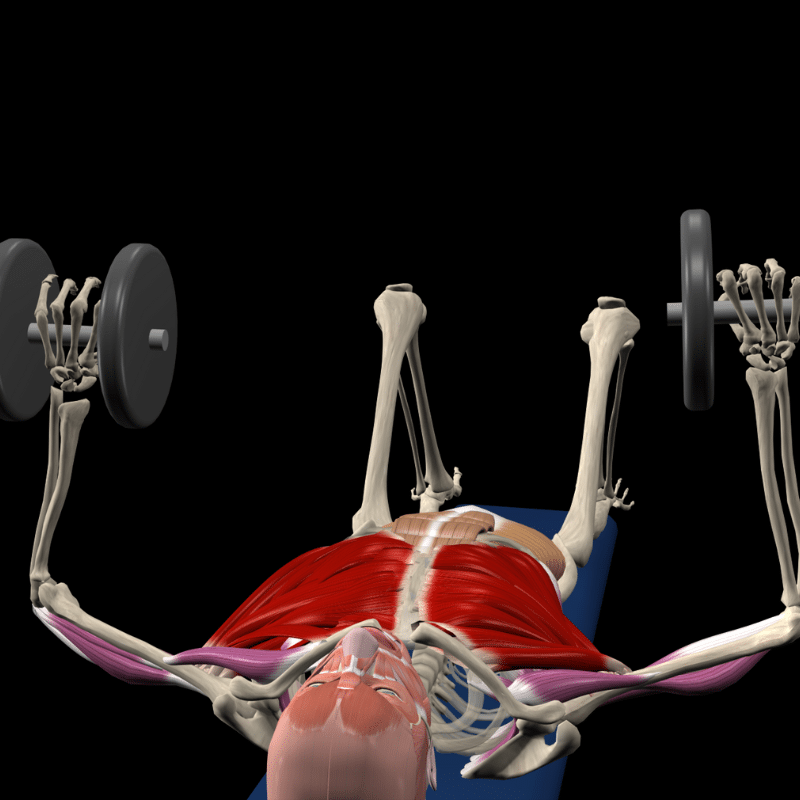For many people, a well-developed chest symbolizes upper body strength and resilience. Beyond aesthetics, a strong chest enhances upper body strength, increases pushing power, and provides vital support for everyday movements. However, access to a barbell isn’t always available, so we at Muscle and Motion have crafted a dedicated dumbbell program for chest development.
This program only requires dumbbells and offers a comprehensive approach to chest training, maximizing muscle engagement, range of motion, and control—all essential for balanced growth and strength.
The unique benefits of dumbbells for chest workouts
Regarding chest training, dumbbells offer several advantages that distinguish them from barbells and machines. They’re versatile, accessible, and offer functional benefits beyond building strength. Here’s why dumbbells can be especially effective for developing a balanced, powerful chest:
- Enhanced range of motion: Unlike a barbell, which limits how far you can lower the weight due to contact with the chest, dumbbells allow you to go as low as your body comfortably permits during various bench press exercises. With each repetition, this greater range of motion enables a full stretch and contraction of the chest muscles. Research highlights that the stretch phase of an exercise is crucial for muscle growth, particularly in beginners, as it promotes better muscle activation and overall development. To learn more, you can read our blog: Stretching and Muscle Length in Hypertrophy.
- Improved stabilization: Dumbbells require each arm to work independently, which engages stabilizing muscles that aren’t as active during barbell exercises. This increased demand for stabilizers around the shoulder, elbow, and wrist helps improve coordination and control, leading to better overall muscular balance. Dumbbells also help address strength imbalances between sides, encouraging even muscle development across the chest and upper body. This focus on stability builds balanced strength and supports injury prevention by strengthening joint-supporting muscles.
- Accessibility and versatility: Dumbbells are often more accessible than barbells, making them a convenient option for many people. Dumbells allow for adjusting angles and movements for various exercises targeting different chest areas, such as the upper, middle, and lower portions. This versatility makes dumbbells ideal for creating a complete chest workout, even in spaces with limited equipment.
These benefits make dumbbells a powerful choice for building a strong, well-rounded chest.

Anatomy of the chest muscles
The primary chest muscles include the pectoralis major and pectoralis minor, each with distinct segments that contribute to different movements and areas of the chest.
Pectoralis major
The pectoralis major, a large, fan-shaped muscle driving most pressing and pushing movements, is divided into three segments: the clavicular head, originating from the medial clavicle; the sternal head, from the sternum and first seven costal cartilages; and the costal head, from the 6th rib cartilage and external oblique. These segments converge into a broad tendon attaching to the lateral lip of the intertubercular sulcus of the humerus.
Supporting muscles in chest exercises
Several key muscles work alongside the pectoralis major in chest exercises, helping to create smooth and stable movements:
- Anterior deltoid: Positioned at the front of the shoulder, the anterior deltoid assists with shoulder flexion and helps raise the arms, providing support to the chest muscles during presses.
- Triceps brachii: Located on the back of the upper arm, the triceps extend the elbow, adding force and stability in pressing movements by pushing the arms forward.
- Serratus anterior: Found along the side of the ribcage, the serratus anterior stabilizes the scapula (shoulder blade) and assists in upward shoulder movement. It’s particularly active in exercises where the arms are pressed overhead, helping to control shoulder positioning.
Together, these muscles support the pectoralis major in pressing exercises, ensuring greater strength, stability, and effective muscle engagement during each movement. To learn more, read the blog Muscles of the Pectoral Region.
Top dumbbell exercises for building a strong chest
Now that we’ve covered the benefits of dumbbell exercises and the anatomy of the chest muscles let’s dive into the best exercises you can perform with dumbbells to build a strong, well-defined chest.
A staple in any chest workout, the flat dumbbell bench press primarily targets the middle portion of the pectoralis major, helping to build strength and thickness in the chest.
How to perform:
- Lie down with your back on a bench and hold a dumbbell in each hand.
- Position the dumbbells directly over your shoulder with straight elbows and palms facing forward.
- Slowly lower the dumbbells with control; your elbows should point slightly outward until you reach chest height.
- Press the dumbbells up until you lock your elbows.
- Repeat for the desired number of repetitions.
The incline angle of the bench places greater emphasis on the upper chest, emphasizing the clavicular head of the pectoralis major.
How to perform:
- Lie back on an incline bench set at 30-45 degrees, holding a dumbbell in each hand. Keep your feet flat on the floor for stability.
- Extend your arms to press the dumbbells up over your chest until they’re directly above your shoulders.
- Once your arms are fully extended, slowly lower the weights back to the starting position,
- Repeat for the desired number of repetitions.
The decline angle shifts the focus to the lower portion of the chest, targeting the costal head of the pectoralis major.
How to perform:
- Set the bench to a slight decline and lie back, holding a dumbbell in each hand.
- Start with the dumbbells directly above your shoulders, palms facing forward.
- Lower the dumbbells down until they are in line with your chest, keeping your elbows pointing slightly outward.
- Press the weights back up to the starting position until your arms are fully extended.
- Repeat for the desired number of repetitions.
The dumbbell fly is an effective isolation exercise that provides a deep stretch in the chest muscles, promoting growth and flexibility.
How to perform:
- Lie back on a flat bench, holding a dumbbell in each hand with palms facing each other.
- Begin with your arms extended above your chest, elbows slightly bent. Slowly lower the dumbbells out to the sides in a wide arc until you feel a stretch across your chest.
- Bring the dumbbells back up by squeezing your chest, maintaining the slight bend in your elbows throughout.
- Repeat for the desired number of repetitions.
In summary, a well-structured dumbbell chest workout effectively builds a strong, balanced chest without the need for a barbell. With exercises that target each area of the chest—upper, middle, and lower—you can enhance muscle engagement, improve strength, and promote symmetry. By following our outlined techniques, you’ll be equipped to create a routine that fits your fitness level and helps you reach your goals.
Want to dive deeper? To learn how to perform the bench press correctly, check out our blog: How to Bench Press Properly. For bodyweight chest exercises that also engage the core, read our blog: 3 Push-Up Exercises with Extra Core. Keep challenging yourself, stay consistent, and enjoy the progress you’ll see in your chest strength and appearance.
Have you ever wondered what makes our anatomical animations so accurate and engaging? Click here to learn about our Quality Commitment and the experts behind our content.
At Muscle and Motion, we believe that knowledge is power, and understanding the ‘why’ behind any exercise is essential for your long-term success.
Let the Strength Training App help you achieve your goals! Sign up for free.


